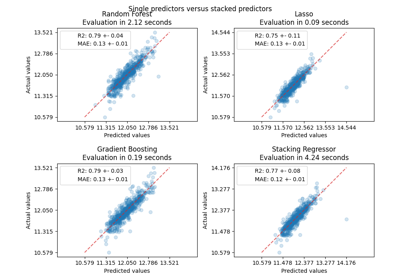StackingRegressor#
- class sklearn.ensemble.StackingRegressor(estimators, final_estimator=None, *, cv=None, n_jobs=None, passthrough=False, verbose=0)#
堆叠估计器与最终回归器。
堆叠泛化包括将单个估计器的输出堆叠起来,并使用回归器计算最终预测。堆叠允许通过将每个估计器的输出作为最终估计器的输入来利用每个估计器的优势。
请注意,
estimators_是在完整的X上拟合的,而final_estimator_是使用交叉验证预测的基估计器进行训练的,使用cross_val_predict。更多信息请参阅 用户指南 。
Added in version 0.22.
- Parameters:
- estimatorslist of (str, estimator)
将堆叠在一起的基估计器。列表中的每个元素定义为一个字符串(即名称)和估计器实例的元组。可以使用
set_params将估计器设置为 ‘drop’。- final_estimatorestimator, default=None
将用于组合基估计器的回归器。默认回归器是
RidgeCV。- cvint, cross-validation generator, iterable, or “prefit”, default=None
确定在
cross_val_predict中使用的交叉验证分割策略,以训练final_estimator。cv 的可能输入包括:None,使用默认的 5 折交叉验证,
整数,指定 (Stratified) KFold 中的折数,
用作交叉验证生成器的对象,
产生训练、测试分割的可迭代对象。
“prefit” 表示假设
estimators已经预先拟合,并跳过交叉验证
对于整数/None 输入,如果估计器是分类器且 y 是二分类或多分类,则使用
StratifiedKFold。在所有其他情况下,使用KFold。这些分割器使用shuffle=False实例化,因此分割在多次调用中将保持一致。请参阅 用户指南 以了解可以在此处使用的各种交叉验证策略。
如果传递 “prefit”,则假设所有
estimators已经拟合。final_estimator_在完整训练集上的estimators预测上进行训练,并且 不 进行交叉验证预测。请注意,如果模型已经在训练堆叠模型的相同数据上进行了训练,则存在非常高的过拟合风险。Added in version 1.1: ‘prefit’ 选项在 1.1 中添加
Note
如果训练样本的数量足够大,增加分割的数量将不会带来好处。实际上,训练时间会增加。
cv不用于模型评估,而是用于预测。- n_jobsint, default=None
所有
estimators的fit过程中并行运行的作业数。None表示 1,除非在joblib.parallel_backend上下文中。-1 表示使用所有处理器。详见术语表。- passthroughbool, default=False
当 False 时,仅使用估计器的预测作为
final_estimator的训练数据。当 True 时,final_estimator在预测以及原始训练数据上进行训练。- verboseint, default=0
详细级别。
- Attributes:
- estimators_list of estimator
estimators参数的元素,已经在训练数据上拟合。如果估计器被设置为'drop',它将不会出现在estimators_中。当cv="prefit"时,estimators_设置为estimators并且不再拟合。- named_estimators_
Bunch 属性,用于按名称访问任何拟合的子估计器。
n_features_in_int特征数量在:term:
fit期间被看到。- feature_names_in_ndarray of shape (
n_features_in_,) 在 fit 期间看到的特征名称。仅当底层估计器在拟合时暴露此类属性时才定义。
Added in version 1.0.
- final_estimator_estimator
拟合的基估计器堆叠的回归器。
- stack_method_list of str
每个基估计器使用的方法。
See also
StackingClassifier堆叠估计器与最终分类器。
References
[1]Wolpert, David H. “Stacked generalization.” Neural networks 5.2 (1992): 241-259.
Examples
>>> from sklearn.datasets import load_diabetes >>> from sklearn.linear_model import RidgeCV >>> from sklearn.svm import LinearSVR >>> from sklearn.ensemble import RandomForestRegressor >>> from sklearn.ensemble import StackingRegressor >>> X, y = load_diabetes(return_X_y=True) >>> estimators = [ ... ('lr', RidgeCV()), ... ('svr', LinearSVR(random_state=42)) ... ] >>> reg = StackingRegressor( ... estimators=estimators, ... final_estimator=RandomForestRegressor(n_estimators=10, ... random_state=42) ... ) >>> from sklearn.model_selection import train_test_split >>> X_train, X_test, y_train, y_test = train_test_split( ... X, y, random_state=42 ... ) >>> reg.fit(X_train, y_train).score(X_test, y_test) 0.3...
- fit(X, y, *, sample_weight=None, **fit_params)#
拟合估计器。
- Parameters:
- X{array-like, sparse matrix},形状为 (n_samples, n_features)
训练向量,其中
n_samples是样本数量,n_features是特征数量。- yarray-like,形状为 (n_samples,)
目标值。
- sample_weightarray-like,形状为 (n_samples,),默认=None
样本权重。如果为 None,则样本权重相等。 请注意,这仅在所有底层估计器都支持样本权重时才受支持。
- **fit_paramsdict
传递给底层估计器的参数。
Added in version 1.6: 仅在
enable_metadata_routing=True时可用,可以通过使用sklearn.set_config(enable_metadata_routing=True)设置。 有关更多详细信息,请参阅 Metadata Routing 用户指南 。
- Returns:
- selfobject
返回一个已拟合的实例。
- fit_transform(X, y, *, sample_weight=None, **fit_params)#
拟合估计器并返回每个估计器对X的预测。
- Parameters:
- X{array-like, sparse matrix},形状为 (n_samples, n_features)
训练向量,其中
n_samples是样本数量,n_features是特征数量。- y形状为 (n_samples,) 的 array-like
目标值。
- sample_weight形状为 (n_samples,) 的 array-like,默认=None
样本权重。如果为 None,则样本等权重。 请注意,这仅在所有底层估计器都支持样本权重时才受支持。
- **fit_paramsdict
传递给底层估计器的参数。
Added in version 1.6: 仅在
enable_metadata_routing=True时可用,可以通过使用sklearn.set_config(enable_metadata_routing=True)设置。 有关更多详细信息,请参阅 Metadata Routing User Guide 。
- Returns:
- y_preds形状为 (n_samples, n_estimators) 的 ndarray
每个估计器的预测输出。
- get_feature_names_out(input_features=None)#
获取变换后的输出特征名称。
- Parameters:
- input_features字符串数组或None,默认=None
输入特征。只有在
passthrough为True时,才使用输入特征名称。如果
input_features为None,则使用feature_names_in_作为输入特征名称。如果feature_names_in_未定义,则生成名称:[x0, x1, ..., x(n_features_in_ - 1)]。如果
input_features是数组类型,则input_features必须与feature_names_in_匹配(如果feature_names_in_已定义)。
如果
passthrough为False,则仅使用estimators的名称来生成输出特征名称。
- Returns:
- feature_names_out字符串对象的ndarray
变换后的特征名称。
- get_metadata_routing()#
获取此对象的元数据路由。
请查看 用户指南 以了解路由机制的工作原理。
Added in version 1.6.
- Returns:
- routingMetadataRouter
MetadataRouter封装的 路由信息。
- get_params(deep=True)#
获取集成估计器的参数。
返回在构造函数中给定的参数以及
estimators参数中包含的估计器。- Parameters:
- deepbool, default=True
设置为True时,获取各种估计器及其参数。
- Returns:
- paramsdict
参数和估计器名称映射到它们的值,或参数名称映射到它们的值。
- property n_features_in_#
特征数量在:term:
fit期间被看到。
- predict(X, **predict_params)#
预测X的目标。
- Parameters:
- X{array-like, sparse matrix},形状为 (n_samples, n_features)
训练向量,其中
n_samples是样本数量,n_features是特征数量。- **predict_paramsdict of str -> obj
传递给
final_estimator的predict方法的参数。注意,这可能用于从某些估计器返回不确定性,使用return_std或return_cov。请注意,它只会考虑最终估计器的不确定性。如果
enable_metadata_routing=False(默认): 参数直接传递给final_estimator的predict方法。如果
enable_metadata_routing=True:参数安全地路由到final_estimator的predict方法。有关更多详细信息,请参阅 Metadata Routing User Guide 。
Changed in version 1.6:
**predict_params可以通过元数据路由 API 进行路由。
- Returns:
- y_predndarray,形状为 (n_samples,) 或 (n_samples, n_output)
预测的目标。
- score(X, y, sample_weight=None)#
返回预测的决定系数。
决定系数 \(R^2\) 定义为 \((1 - rac{u}{v})\) ,其中 \(u\) 是残差平方和
((y_true - y_pred)** 2).sum(),而 \(v\) 是总平方和((y_true - y_true.mean()) ** 2).sum()。最好的可能得分是 1.0,它可能是负的(因为模型可能任意地差)。一个总是预测y的期望值的常数模型,忽略输入特征,将得到 \(R^2\) 得分为 0.0。- Parameters:
- Xarray-like of shape (n_samples, n_features)
测试样本。对于某些估计器,这可能是一个预计算的核矩阵或一个形状为
(n_samples, n_samples_fitted)的通用对象列表,其中n_samples_fitted是估计器拟合中使用的样本数量。- yarray-like of shape (n_samples,) or (n_samples, n_outputs)
X的真实值。- sample_weightarray-like of shape (n_samples,), default=None
样本权重。
- Returns:
- scorefloat
\(R^2\) 相对于
y的self.predict(X)。
Notes
在调用回归器的
score时使用的 \(R^2\) 得分从 0.23 版本开始使用multioutput='uniform_average'以保持与r2_score默认值一致。 这影响了所有多输出回归器的score方法(除了MultiOutputRegressor)。
- set_fit_request(*, sample_weight: bool | None | str = '$UNCHANGED$') StackingRegressor#
Request metadata passed to the
fitmethod.Note that this method is only relevant if
enable_metadata_routing=True(seesklearn.set_config). Please see User Guide on how the routing mechanism works.The options for each parameter are:
True: metadata is requested, and passed tofitif provided. The request is ignored if metadata is not provided.False: metadata is not requested and the meta-estimator will not pass it tofit.None: metadata is not requested, and the meta-estimator will raise an error if the user provides it.str: metadata should be passed to the meta-estimator with this given alias instead of the original name.
The default (
sklearn.utils.metadata_routing.UNCHANGED) retains the existing request. This allows you to change the request for some parameters and not others.Added in version 1.3.
Note
This method is only relevant if this estimator is used as a sub-estimator of a meta-estimator, e.g. used inside a
Pipeline. Otherwise it has no effect.- Parameters:
- sample_weightstr, True, False, or None, default=sklearn.utils.metadata_routing.UNCHANGED
Metadata routing for
sample_weightparameter infit.
- Returns:
- selfobject
The updated object.
- set_output(*, transform=None)#
设置输出容器。
请参阅 介绍 set_output API 以了解如何使用API的示例。
- Parameters:
- transform{“default”, “pandas”, “polars”}, 默认=None
配置
transform和fit_transform的输出。"default": 转换器的默认输出格式"pandas": DataFrame 输出"polars": Polars 输出None: 转换配置不变
Added in version 1.4:
"polars"选项已添加。
- Returns:
- self估计器实例
估计器实例。
- set_params(**params)#
设置集成估计器的参数。
有效的参数键可以通过
get_params()列出。请注意,您可以直接设置estimators中包含的估计器的参数。- Parameters:
- **params关键字参数
使用例如
set_params(parameter_name=new_value)设置特定参数。此外,除了设置估计器的参数外,还可以设置或通过将它们设置为 ‘drop’ 来移除估计器中的单个估计器。
- Returns:
- self对象
估计器实例。
- set_score_request(*, sample_weight: bool | None | str = '$UNCHANGED$') StackingRegressor#
Request metadata passed to the
scoremethod.Note that this method is only relevant if
enable_metadata_routing=True(seesklearn.set_config). Please see User Guide on how the routing mechanism works.The options for each parameter are:
True: metadata is requested, and passed toscoreif provided. The request is ignored if metadata is not provided.False: metadata is not requested and the meta-estimator will not pass it toscore.None: metadata is not requested, and the meta-estimator will raise an error if the user provides it.str: metadata should be passed to the meta-estimator with this given alias instead of the original name.
The default (
sklearn.utils.metadata_routing.UNCHANGED) retains the existing request. This allows you to change the request for some parameters and not others.Added in version 1.3.
Note
This method is only relevant if this estimator is used as a sub-estimator of a meta-estimator, e.g. used inside a
Pipeline. Otherwise it has no effect.- Parameters:
- sample_weightstr, True, False, or None, default=sklearn.utils.metadata_routing.UNCHANGED
Metadata routing for
sample_weightparameter inscore.
- Returns:
- selfobject
The updated object.
- transform(X)#
返回每个估计器对X的预测结果。
- Parameters:
- X{array-like, sparse matrix},形状为 (n_samples, n_features)
训练向量,其中
n_samples是样本数量,n_features是特征数量。
- Returns:
- y_preds形状为 (n_samples, n_estimators) 的 ndarray
每个估计器的预测输出。


